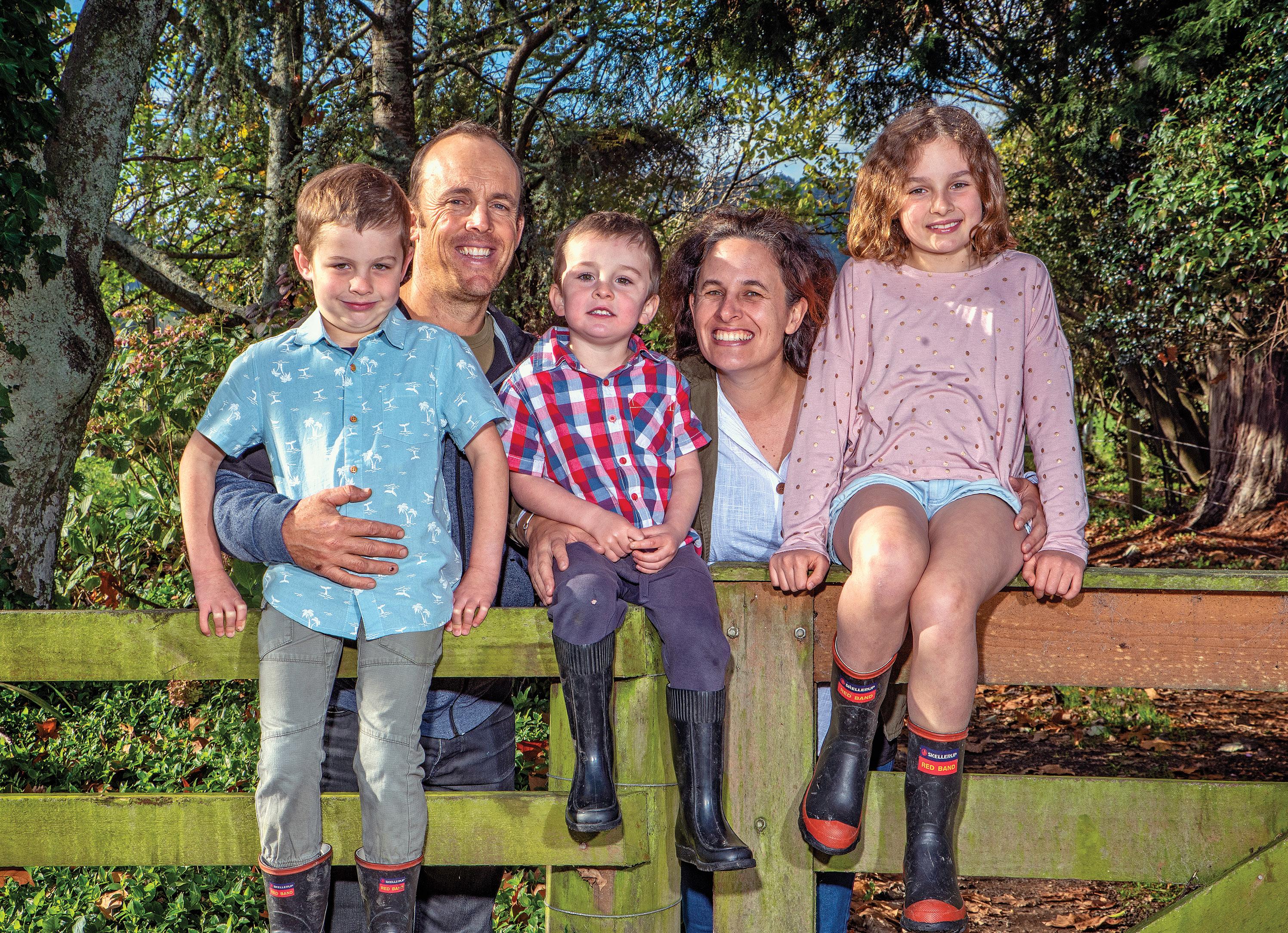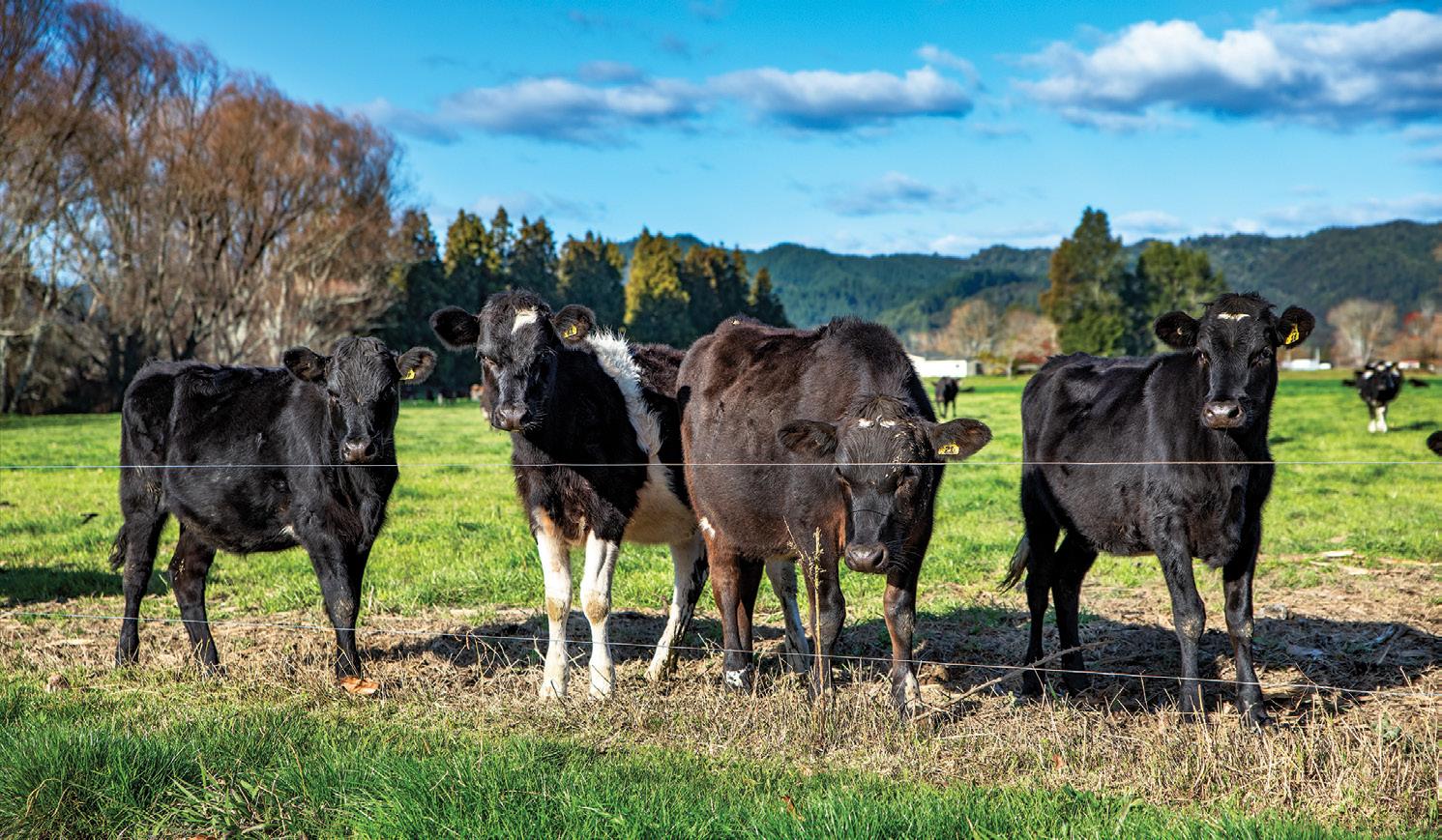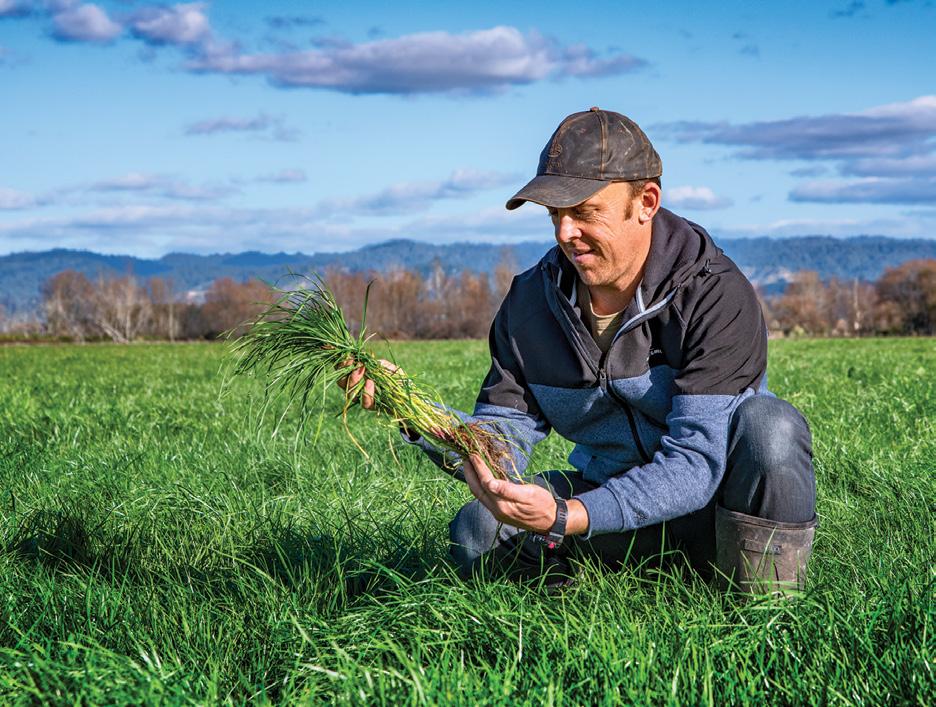
13 minute read
Doing what’s right’ for whole farm wins awards
ENVIRONMENT IMPROVEMENTS
“Doing what’s right” for the whole farm wins awards
An holistic approach to dairying that involves the health of soils, waterways, bush, wetlands, stock, staff and themselves has won accolades for Bay of Plenty farmers. Elaine Fisher reports. Photos by Troy Baker.
Affording cows the same respect and consideration they would like to receive themselves is part of Fraser and Katherine McGougan’s animal management policy.
It fits exactly with their mission statement; “Do What’s Right”, which the couple applies to all aspects of their farming business.
“This year we have introduced a no-dog policy and encourage people not to follow cows or use anything but their voice and presence to move cattle, and as a result we have had very little lameness,” says Fraser, who is the fourth generation of his family to farm Willowvale Farm at Taneatua.
“Treating cows as you would like to be treated is not airy fairy. It is about good stockmanship and there are economic benefits. Lameness can affect a cow’s milk production, fertility, and overall health.”
Technipharm Batt-Latch timers used to open gates allow cows to walk to the cowshed or between paddocks themselves, leaving staff to check paddocks, shut gates, and set up the next paddock for grazing.
Fraser has also paid attention to the maintenance of and material used on races. “A DairyNZ consultant once told me if I didn’t mind walking on the race in bare feet then the cows won’t either.”
An underpass in the road that divides the farm has been installed to improve ease of movement for cows and the local community. “There was no direct financial
Left: Katherine and Fraser McGougan and their children Emily (8), Isaac (6) and Liam (3) of Willowvale Farm which has been in the McGougan family since 1898.
FARM FACTS:
• Farm name: Willowvale Farms Ltd • Owners: Fraser and Katherine
McGougan • Location: Opouriao Valley,
Taneatua, Eastern Bay of Plenty • Area: 150ha, 136ha effective • Topography: Flat • Herd: 420 peak milked (3.2 cows per ha) • Production: 1130kg MS/ha and 346kg MS/cow (3 year average) • BW 127 PW 158 • System 2 – 10% imported feed

benefit to our farm but it was the right thing to do.”
Katherine and Fraser’s approach to dairy farming is holistic. They consider the health of their soils, waterways, native bush, wetlands, stock, staff, and themselves in management plans.
Putting that into practice is among the reasons the couple won the Regional Supreme Award in the 2019 Bay of Plenty Ballance Farm Environment Awards, and why Fraser is a DairyNZ Climate Change Ambassador.
The farm environment award judges said the couple have “a passion for the future of the dairy industry that motivates Fraser and Katherine to become involved outside the farmgate.
“Fraser and Katherine make a great team with complementary skills. They have great understanding of farm financials, key metrics, and cost control; excellent HR practices and policies – evidenced by the ongoing success achieved by their employees. Fraser’s enthusiasm for collecting information and learning more about soils and nutrients is remarkable.”
It’s a source of pride for Fraser and Katherine that the family has been on the land since it was settled by Fraser’s great grandfather in 1898. However, says Fraser, “our family history guides us but does not constrain us”.
Although he grew up on Willowvale Farm in the Opouriao Valley, five kilometres south of Taneatua, Fraser didn’t go farming immediately after leaving school. He completed an agricultural degree at Massey University then headed overseas “for a few years finding out what I didn’t want to do and came back to farming, progressing my way through the industry.”
Katherine grew up on a dairy farm at Tokoroa and qualified as a radiation therapist, a career she had to let go when she moved to Taneatua.
Katherine is responsible for the financial and administrative functions on the farm and oversees the human resources systems and processes that include recruitment, performance reviews for their two full-time staff, training, and exit interviews, as well as caring for the couple’s three children, Emily (8), Isaac (6) and Liam (3).
The couple formed an equity farming partnership with Fraser’s parents in 2004. Remaining shares were acquired in 2011 and, after leasing it for six years, a neighbouring property was purchased in 2017 to add to the home farm.
Now Fraser and Katherine have outright ownership of the property that totals
Left: The property has three significant areas of native bush, featuring stands of kahikatea and other native tree species. These have all been fenced off and developed with further plantings.
Below: A lined effluent pond with a variable speed drive stirrer is part of the upgraded effluent system on Willowvale Farm.

150ha hectares (136ha effective), and milk 420 crossbred cows. It is essentially a closed herd, except for breeding bulls, and it is fertile – four weeks of AB ensures an excess of heifer replacement calves.
“Our stocking rate pushed up to 440 cows but we tweaked that back a little and actually increased production. Last season’s production was 152,500 kg MS, which is not through the roof but is around our 10- year average. We do not winter off or use much bought-in supplementary feed. We are a System 2 farm and grow most of our silage and hay onfarm.”
Mob sizes are kept small over winter with around 110 cows in each of four herds. “Cows calve within their own herds. We don’t have springer mobs. Four herds do make more work for us but there is less damage to pasture and the animals are happier.”
When necessary in winter, cows can be
An underpass in the road which divides Willowvale Farm has been installed to improve ease of movement for cows and the local community.

stood off and fed hay on paddocks with shingle subsoils or moved to the nearby runoff that has free-draining pumice soils.
In 2017 the three-year performance average of the dairy farm was 1130kg MS/ ha and 346kg MS/cow. This compares well with the Bay of Plenty average of 968kg MS/ha and 352kg Ms/cow for the 2016-17 season. (Source: DairyNZ Economic Survey 2016-17). Approximately 10% of feed is bought in from off farm.
The Whakatane River forms one of Willowvale Farm’s boundaries and in autumn 2017 the property was severely affected by floods, now referred to as the Edgecumbe Floods, which saw that town inundated when a stopbank failed.
“We are always more adversely affected by rain than dry, especially a wet spring. The Eastern Bay hills around Taneatua and Opotiki generally get more rain than other areas.”
Conscious of the debt they carry, Katherine and Fraser are focused on their breakeven milk price (BEMP) that, alongside debt-to-equity ratio, is used to gauge financial performance and drive financial discipline across the business. BEMP for the 2014-2017 period was within the range of $3.50 -$3.86/kg MS despite the additional expenses imposed by the 2017 floods and modifications to the cowshed and farm cottage. This compares extremely favourably with Bay of Plenty values, which are typically in the $4-$5/kg MS range.
Careful management is crucial to the farming operation’s success and also to its long-term environmental sustainability. Up to 30% of the farm is prone to flooding and its overall contour is flat with three distinctly different soil types; Whakatane fine sandy loam, Opouriao fine sandy loam, and Rewatu fine sandy loam.
“Each soil type behaves differently. Those on the lower contour have a stony subsoil and drain well while the heavier soils need Novaflo drains. We carry out individual paddock soil samples to find out the specific nutrients needed and that’s beginning to show us trends. Opouriao silt loams hold onto P and it is readily available to plants. K levels are also a lot better than so-called modelling shows.”
That information has led to targeted fertiliser application per paddock. “We are not using a lot less fert but are using it a lot smarter and seeing the gains, such as increased yield from maize crops.” Covered fertiliser bins have been constructed and GPS technology is used to guide fertiliser application using the farm’s own tractor, spreader, and staff.
“Liming rates unlock a lot of nutrients from our acid soils so we can enhance the available nutrients simply by putting on lime.”
Last year, to increase his understanding of the impacts of fertiliser and soils, Fraser completed an in-house Massey University Sustainable Nutrient Management Course (the same course fertiliser consultants complete).
“As a farmer I needed to know I could make the best decisions for our farm and not rely on someone else. I did it to upskill decision making around nutrients and nutrient losses.”
The Olsen P phosphate target level for the farm is 33. Soil pH is addressed through a regular liming programme in accordance with soil testing, and shed effluent is used to complement the fertiliser programme across the effluent area, which extends to 48 ha (35% of effective area), where no additional fertiliser is added. From the nutrient budget, 37 kgN/ha/year is lost to groundwater through leaching.
Reducing nutrient loss and enhancing the environment are important to Katherine and Fraser who have continued to plant and fence out waterways, change drainage systems where needed, and decrease stocking rates.
Willowvale has a 34-bale Waikato Milking Systems rotary plant, set up to be
run by just one milker, with automatic cup removers, teat sprayers, and bail restraints. A big focus has been on the reduction in water use resulting in just 7.5 m3 used each day to wash down yards and the plant during summer. (Industry average is around 70l/cow/day, or 29.4m3 for 440 cows).
“We invested in a water meter to monitor use, and in storage tanks. Recycled green water is used for flood washing of the yard. We’ve gained big efficiencies but, with the latest upgrade, will push for more.”
Upgrades carried out this year included triple sediment traps, a solid storage area, and a lined effluent pond with a variable speed drive stirrer. “It’s been a big cost in time and money but was what was needed to stay ahead, even though the existing system had resource consent until 2025. The new upgrade should give us another 15 years.”
The dairy also has an innovative heat recovery unit to improve energy efficiency by using the heat generated from the milk vat chillers to heat plant wash water.
Effluent is irrigated onto pasture but Fraser says the amount available is not great. “One of the biggest things often overlooked is that the less water used in cowsheds, the less effluent you have to get rid of. For us, having a low volume of concentrated liquid is easier to distribute and less risk to the environment.”
Solids are spread onto paddocks, which are cultivated and sown in maize for onfarm feed. Those paddocks are also part of the annual pasture renovation programme. Willowvale paddocks grow a lot of paspalum and there’s an increasing incidence of kikuyu too, something Fraser expects will only get worse with global warming.
“We regrass five to six percent of our pasture every year and our farming system benefits from the new pasture. Undersowing does not work because the paspalum is so dominant.”
The property has three significant areas of native bush featuring stands of kahikatea and other native tree species. These have all been fenced off and developed with further plantings done in partnership with the Bay of Plenty Regional Council. The bush areas are now under a covenant to protect them into the future.
Fraser was already a member of the Whakatane River Advisory group when he volunteered to be a DairyNZ Climate


Left top: Fraser McGougan takes individual paddock soil samples to find out the specific nutrients needs of each.
Left: GPS technology is used to guide fertiliser application, using the farms own tractor, spreader and staff.
Below: Cross-bred cows which make up the Willowvale Farm herd.
Bottom: Farm’s spreader which enables fertiliser to be applied at the optimum time and rates for the Taneatua farm.



Change Ambassador. “I am aware of the changing face of agriculture and want to understand better the threats and opportunities and to engage with others and upskill ourselves.
“The role is basically about getting information and disseminating it to other farmers, providing feedback around what we are experiencing or seeing other people experience, and asking questions. The role has progressed to providing some feedback to national and local government organisations.”
Fraser found the information he needed about the environment and farming hard to access, which prompted him and Katherine to enter the Ballance Farm Environment Awards.
“It was a really good experience, which opened our eyes to what other people are doing. There is a lot to be learned from our own and other industries. You can never have all the answers yourself and there’s no point in reinventing the wheel. If you try to do things on your own you may not come up with the best solution. Learning from other farmers and growers is actually more empowering. It strengthens your business and everyone else’s business and the community as well.”
Fraser pushed hard to get pan-sector discussion groups going in the Bay of Plenty and the first, the Pan Sector Future Farming Symposium, attracted 350 people from horticulture, dairying, dry stock farming and the community. A second event, planned for May, was cancelled because of Covid-19.
“What we are facing from climate change, environmental, and freshwater

Left: The effluent system at Willowvale Farm has been upgraded this season. Top: No fertiliser, other than cowshed effluent, is spread on this paddock which in late May had an impressive grass sward. Bottom: It’s a source of pride for Fraser and Katherine that the family has been on the land since it was settled by Fraser’s great grandfather in 1898. However, says Fraser, “our family history guides us but does not constrain us”.
issues are not just a dairy problem, or agricultural or horticultural problem. They affect us all, including urban populations.”
DairyNZ had done a good job on behalf of farmers through some tough negotiations around the government’s national freshwater policy, especially in regard to fencing requirements, he says. The policy sets standards for managing nitrate limits, creating healthy rivers and streams to swim, fencing off stream banks, and riparian planting.
“The biggest thing is how regional councils interpret and enforce the rules. Farmers must have ownership of their own farm plans because that way you have engagement. When plans become a compliance issue, they lose value.
“I found completing our farm plan really empowering. It opened our eyes to the opportunities and threats we face and provided a clear pathway forward. Forming a plan is worth the effort. We used the Fonterra Tiaki programme, which is wellresourced and very professional.”
Fraser believes climate change offers both challenges and opportunities but says anyone looking for simple solutions will be disappointed. He’s also urging the government to be realistic about what can be achieved through its environmental policies.
“It has to be recognised that agriculture is an export earner, which also feeds New Zealanders and provides employment and prosperity. We can’t turn our farms into habitat for all our native flora and fauna and continue to farm economically.”











